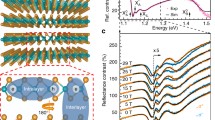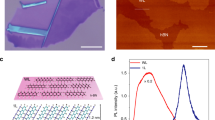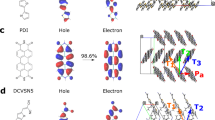Abstract
We predict an efficient electronic energy transfer from the two-dimensional Wannier-Mott excitons confined in a semiconductor quantum well to the optically active organic molecules of the nearby medium (substrate and/or overlayer). The energy transfer mechanism is of the Förster type and, at semiconductor-organic distances of several nanometers, can easily be as fast as 100 ps, which is about an order of magnitude shorter than the average exciton lifetime in an isolated quantum well. Under such conditions, the Wannier-Mott exciton luminescence is quenched and the organic luminescence is efficiently turned on. Our calculations, combining a microscopic quantum mechanical exciton model with a macroscopic electrodynamic description of the organic medium, take into account the dielectric constant discontinuities and can be applied to any organic-inorganic multilayer structure.
Similar content being viewed by others
References
J. R. Sheats, Science 277, 191 (1997), and references therein.
V. G. Kozlov, V. Bulović, P. E. Burrows, and S. R. Forrest, Nature 389, 362 (1997).
M. Berggren, A. Dodabalapur, R. E. Slusher and Z. Bao, Nature 389, 466 (1997).
V. M. Agranovich, R. Atanasov, and F. Bassani, Solid State Commun. 92, 295 (1994).
G. C. La Rocca, F. Bassani, and V. M. Agranovich, Nuovo Cimento D 17, 1555 (1995).
A similar idea has been used to calculate the energy transfer from an excited dye molecule to the surrounding solution, considering the molecule as a point classical dipole and the solution as a continuous absorbing medium: M. D. Galanin and I. M. Frank, Zh. Éksp. Teor. Fiz. 21, 114 (1951); M. D. Galanin, Zh. Éksp. Teor. Fiz. 21, 126 (1951).
L. D. Landau and E. M. Lifshitz, Electrodynamics of Continuous Media, Pergamon Press, Oxford, 1960, paragraph 61.
P. Y. Yu and M. Cardona, Fundamentals of Semiconductors, Springer-Verlag, Berlin, 1996, Ch. 9.
T. Yamada, H. Hoshi, T. Manaka et al., Phys. Rev. B 53, R13314 (1996).
A. F. Hebard, R. C. Haddon, R. M. Fleming and A. R. Kortan, Appl. Phys. Lett. 59, 2109 (1991).
Author information
Authors and Affiliations
Additional information
Pis’ma Zh. Éksp. Teor. Fiz. 66, No. 11, 714–717 (10 December 1997)
Published in English in the original Russian journal. Edited by Steve Torstveit.
Rights and permissions
About this article
Cite this article
Agranovich, V.M., La Rocca, G.C. & Bassani, F. Efficient electronic energy transfer from a semiconductor quantum well to an organic material. Jetp Lett. 66, 748–751 (1997). https://doi.org/10.1134/1.567592
Received:
Issue Date:
DOI: https://doi.org/10.1134/1.567592




